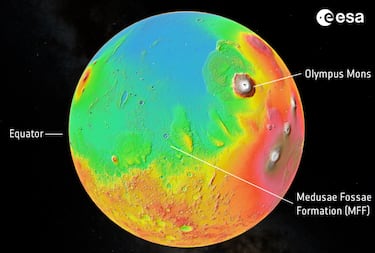The water frozen under the surface of Mars could cover the entire planet if it melted
The ESA has found a huge deposit of water buried under the red dust of Mars, which in turn will help scientists understand the climate history of the planet.

In the distant past, the red planet was covered in oceans. Mars now has an appearance that has nothing to do with the image that the Earth projects from space: the blue has been diluted in the sandy wasteland that covers the surface of the planet, but the Mars Express probe of the European Space Agency (ESA) has discovered that a water reservoir up to 2.5 km deep lies buried beneath the equator, in a frozen state. Although this is not the first time ice has been discovered in this location, the amount of water is much larger, to the point that it could cover the planet if it thawed.
“We’ve explored the MFF again using newer data from Mars Express’s MARSIS radar, and found the deposits to be even thicker than we thought: up to 3.7 km thick” explained Thomas Watters, from the Smithsonian Institute, the author of both the initial 2007 study and the current research. According to their words, the radar signals “match” their expectations. Furthermore, they “are similar to the signals we see from Mars’s polar caps, which we know to be very ice rich.”
If it melted, it would cover the entire planet with “a layer of water 1.5 to 2.7 meters deep”, so “enough water has been found in this part of Mars to completely cover Earth’s Red Sea.”

The implications of the research: More signs of Mars’ blue past
The red planet appears to be an arid world today, but the surface is full of evidence that water was abundant in the past, as you can find empty river basins, canals, ancient oceans, valleys chiseled by water and remains of lakes. “We’ve also found significant stores of water ice on Mars, such as the enormous polar caps, buried glaciers nearer the equator, and near-surface ice laced through martian soil.”
Related stories
For Colin Wilson, ESA scientist on Mars Express, These latest analyzes raise as many questions as they answer: “How long ago did these ice deposits form, and what was Mars like at that time? If confirmed to be water ice, these massive deposits would change our understanding of Mars climate history. Any reservoir of ancient water would be a fascinating target for human or robotic exploration”

“Unfortunately, these MFF deposits are covered by hundreds of metres of dust, making them inaccessible for at least the next few decades. However, every bit of ice we find helps us build a better picture of where Mars’s water has flowed before, and where it can be found today.”


